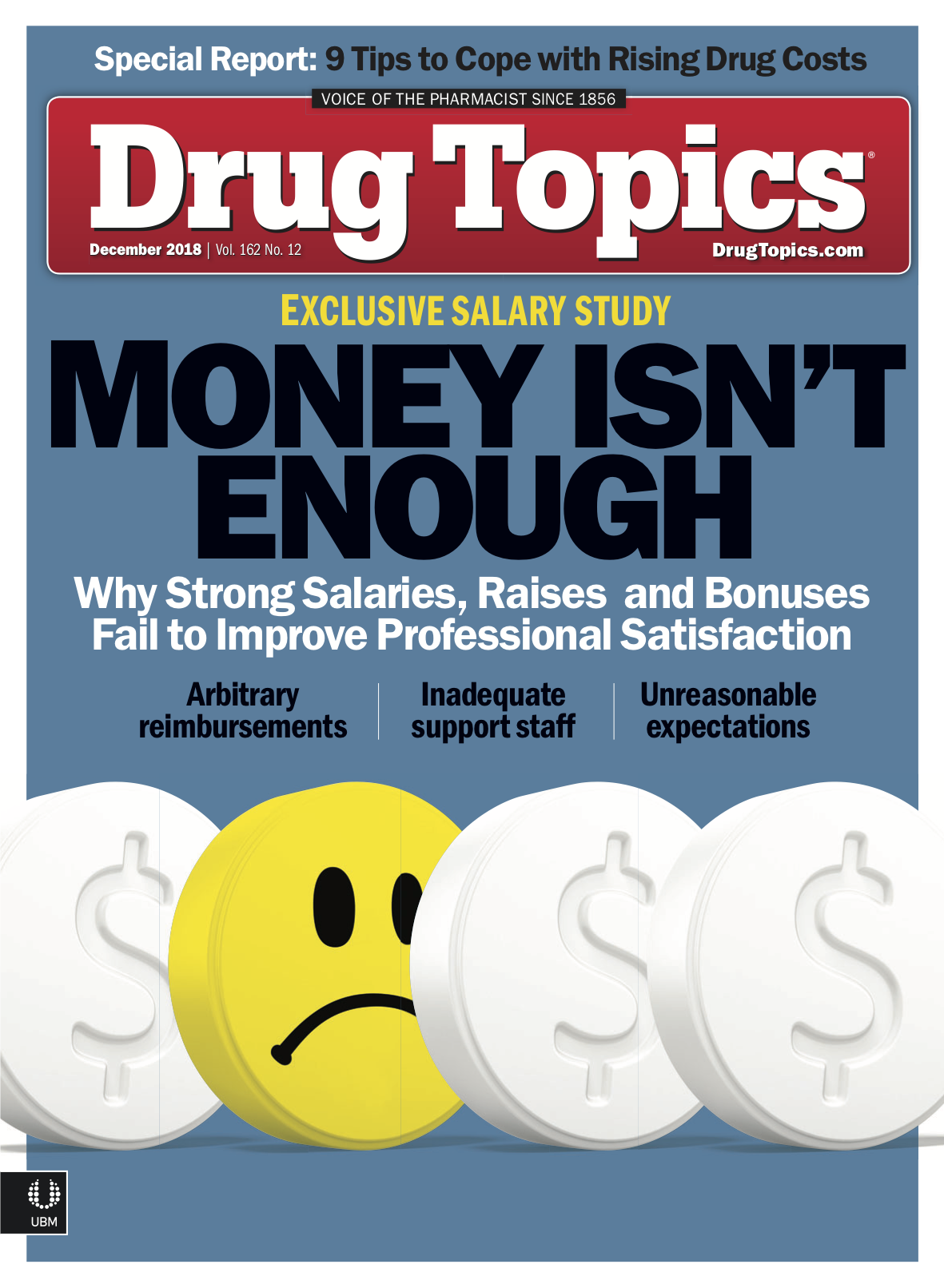Annual Salary Survey Results: Money Isn't Enough
Results from DrugTopics' annual salary survey suggested that salaries, raises, and bonuses fail to improve pharmacists' professional satisfaction.
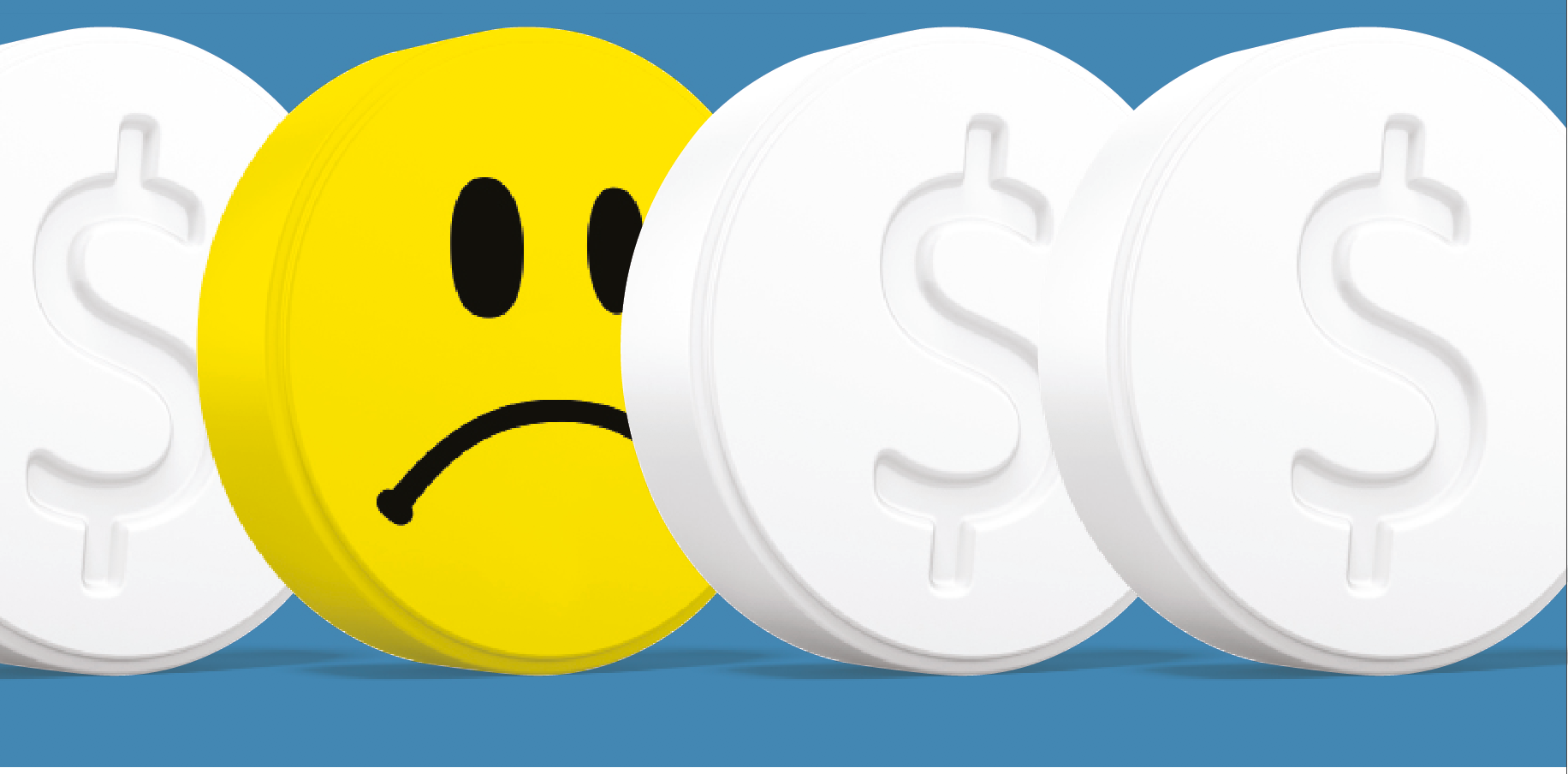
Job got you down?
As pharmacists continue to battle professional challenges that include low payments, hidden fees, higher volumes, insufficient support , and a healthcare system that relegates them to a service department, it appears as though no amount of money could offset systemic frustrations. Pharmacist compensation continues to rise, but modest financial increases aren’t making pharmacists any more satisfied in their jobs, according to the annual Drug Topics Salary and Job Satisfaction Study (see Methodology). For the third year in a row, pharmacists report higher workloads, more stress, and less overall job satisfaction despite individual incomes that are twice the national average than those of entire households.
More than 70% of pharmacists earn at least $120,000 per year with significant bonuses and benefits, yet more than a quarter of pharmacists are dissatisfied in their current position, and 41% say they are not adequately compensated for the work they do. The reasons for their disillusion are primarily caused by the mix of workload expectations, insufficient support, and variable reimbursements that many consider arbitrary.
Continue reading on page 2...
Chart 1: Annual salaries by gender and education level
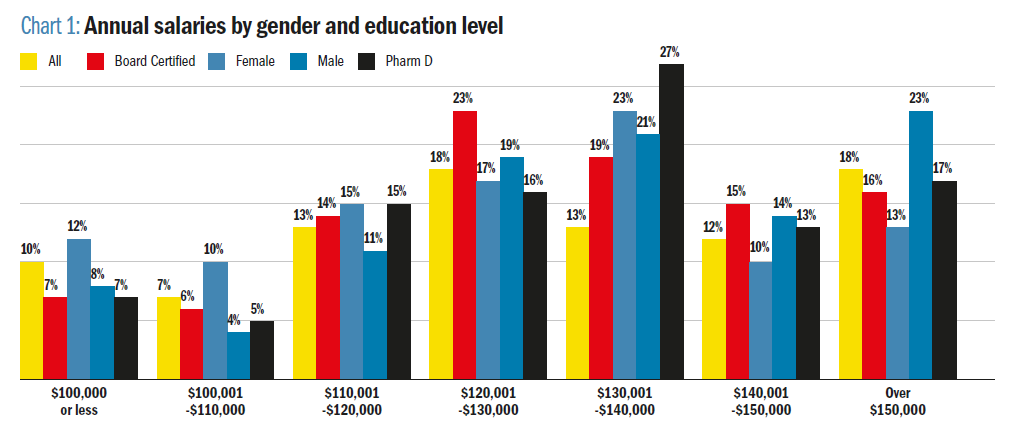
Compensation
Half of pharmacists are paid salaries while half work on an hourly basis. In 2016, 57% of pharmacists were salaried employees; 52% were salaried last year, and this year’s even split continues the trend toward hourly employment. More than two-thirds of respondents work between 30 hours and 44 hours per week; 12% work fewer than 30 hours, and 19% work at least 45 hours per week. Few (2%) reported working more than 60 hours per week.
Salaries remained strong in 2018: 71% of respondents made more than $120,000 this year, on par with last year but up significantly from 2016, when just 61% made at least $120,000. Another positive trend: 18% of respondents made more than $150,000 this year, up from 15% last year and up from 7% in 2016 (Chart 1). The more salaries at the top of the range show that despite the glut of graduating pharmacists, there is still room at the top for those with management experience and those willing to work in high-volume locations in big cities.
Hospital pharmacists tend to make more money: 82% of hospital workers make more than $120,000 per year; 25% make at least $150,000, and just 5% make less than $100,000 per year compared to 10% of all pharmacists who make less than $100,000. Similarly, managed care pharmacists and those who work in nursing home/long-term care pharmacy are more likely to earn salaries (66%) versus an hourly wage, and 32% earn more than $150,000 per year, making health system pharmacists almost twice as likely to earn salaries in the top range for the profession. Not surprisingly, health system pharmacists are more likely to receive regular raises (68%) but less likely to receive bonuses or additional incentives; 70% of health system pharmacists say they are adequately compensated for what they do, and just 15% say they are dissatisfied in their work compared to 27% of all pharmacists.
Does higher education mean more money? The short answer is yes, but there appears be a point of diminishing return. Only 14% of those who are board certified say their certification helped them draw a higher salary; 10% are unsure, and more than 75% say it has no impact on salary. The data (Chart 1) confirms that sentiment: 74% of board-certified pharmacists make more than $120,000 per year, just a tick above overall respondents. They are no more likely to say they are adequately compensated, satisfied with their current positions, and receive regular raises or bonuses.
Continue reading on page 3...
Chart 2: Wages correlate to salaries in terms of education, gender, and type of pharmacy.

Chart 3: Just 47% of pharmacists got raises in 2018, but percentage increases held steady
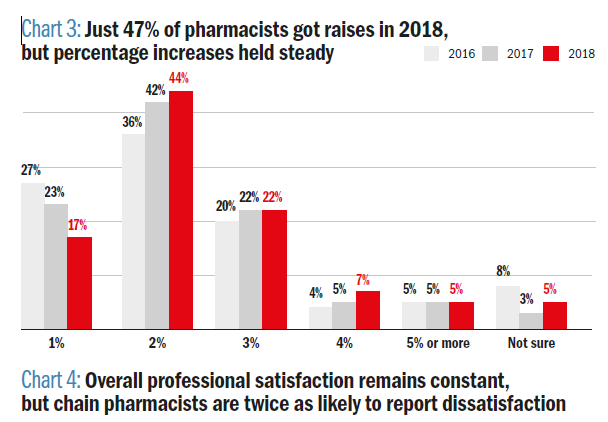
Wages, Raises, and Bonuses
Wages (Chart 2) generally correlate to salary. Health-system pharmacists earn more per hour than community pharmacists, and education level has a marginal effect on earnings. One troubling trend is a decline in regular raises: 47% of all respondents received a raise in 2018, down from 53% last year and 62% in 2016. For those who received raises, the lion’s share were 3% or less, similar to years past (Chart 3).
Additionally, the number of pharmacists receiving bonuses, incentive pay, or other profit-sharing rewards continues to decline. In 2016, 55% of pharmacists received a bonus; that number fell to 43% last year and 42% in 2018. Two-thirds of those who received additional bonuses say those earnings were $5,000 or less; 15% earned between $5,000 and $10,000, and 15% received bonuses of $15,000 or more, up from 7% in 2016.
Men tend to receive larger bonuses than women, although this could be attributed to tenure, as 60% of men have at least 25 years of experience versus 45% of women. While men and women received bonuses at a similar rate, 44% and 40% respectively, men (20%) were more than twice as likely to receive a bonus of at least $15,000 versus women (9%); 57% of men received bonuses of less than $5,000, whereas 73% of women who earned bonuses received less than $5,000.
Continue reading on page 4...
Chart 4: Overall professional satisfaction remains constant, but chain pharmacists are twice as likely to report dissatisfaction
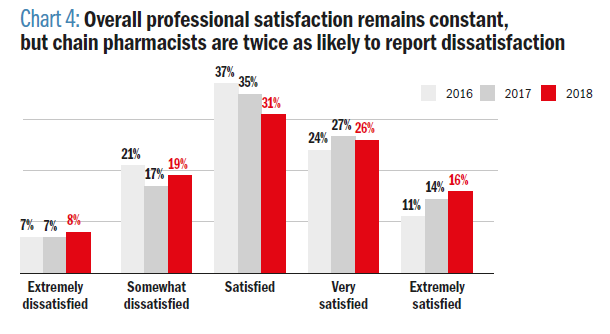
Chart 5: Why has your stress level at work increased?

Chart 6: What are your reasons for considering a job change?
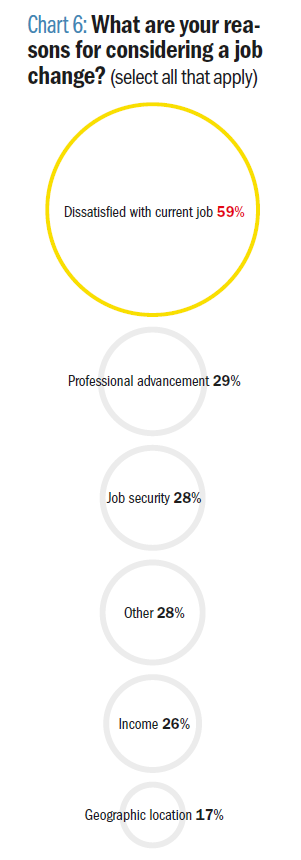
Chart 7: During flue season, how many flu vaccines do you give in a typical week?
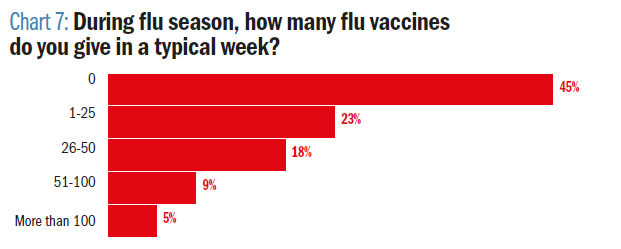
Satisfaction
Job satisfaction metrics haven’t changed significantly in the past few years, which means they still aren’t good (Chart 4); 27% of respondents say that are dissatisfied in their work in some way, and almost one-third of respondents (29%) say that are considering a job change in the next 12 months, up slightly from 27% from last year and on par with 2016 numbers.
Two-thirds of respondents say they have more stress compared to last year, up from 60% in 2017 who said their stress had increased. Similarly, 72% said workload increased versus last year’s workloads, and just 4% say their stress and workload had decreased, although many who reported less work and stress had voluntarily reduced their responsibilities, for reasons like their run up to retirement.
The reasons why job stress is on the rise and job satisfaction is low is fairly predictable: Increased workload volume and inadequate support staff reign as the largest frustrations (Chart 5). With increased responsibilities for MTM, vaccinations, and patient-care services that are migrating to pharmacies, there is a critical need for better-paid and better-educated technicians, but this isn’t happening in the current environment driven by employee-per-volume metrics.
Paperwork, EMRs, and practice management software aren’t making work easier, either: 45% say documentation is a cause of stress, much of it a result of antiquated management/patient systems or inadequate training on new systems.
The DIR system, hidden fees, coercive negotiating practices by PBMs, and audits continue to be major frustrations for community pharmacists who own and/or manage purchasing for their outlet, driving many to look for greener pastures elsewhere. It’s unclear the extent to which the current healthcare system contributes to general sentiments about income (or revenue), job satisfaction, and poor workplace environment, which is also a major factor driving pharmacists to find new jobs. Professional advancement, job security, and income were cited by more than 1 in 4 as reasons for looking for new work (Chart 6).
Administering vaccinations is a growing reality for pharmacists, but the brunt of vaccinations happen at community chain pharmacies. Not surprisingly, 75% of chain pharmacists say they must deal with unrealistic vaccination quotas compared to one-third of overall respondents and other community pharmacists; 59% of chain pharmacists say it takes up too much of their time compared to 29% of all pharmacists and 33% of other community pharmacists. There isn’t much wondering why: 45% of all pharmacists do not administer any flu shots, whereas just 4% chain pharmacists skip the duty. One in three chain pharmacists administer more than 50 flu vaccines each week during peak season compared to 13% or all pharmacists and 12% of other community pharmacists (Chart 7).
The burden of vaccinations, corporate politics, workflow metrics, and the lack of time to give patients the information they need lead chain pharmacists to be the most disenfranchised sector of the profession. More than half (53%) of chain pharmacists say they are dissatisfied with their jobs, almost twice the proportion of the overall profession.
How does all this translate to the duty pharmacists have to their patients? In short, 71% say they are able to give patients the information and tools they need to be healthier; 17% are neutral, and 12% say they cannot give these services. For chain pharmacists, the workload toll is a concern for patient health. Double the number of chain pharmacists (24%) say they are unable to make patients healthier versus 58% that say they are able to deliver health information and tools.
Up next: Survey Information
Methodology and Demographics
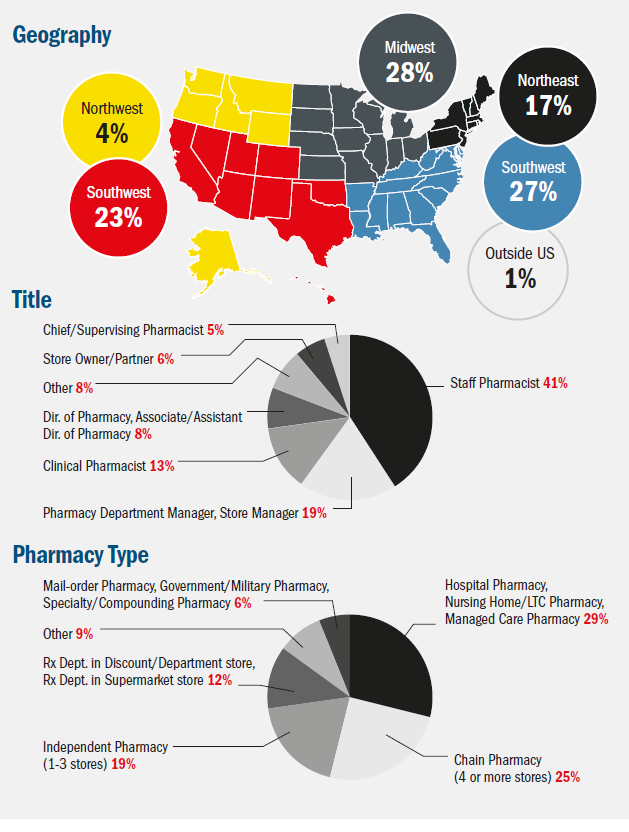
Methodology and Demographics
The Drug Topics Annual Pharmacist Salary and Job Satisfaction survey was emailed to our newsletter audience on Sept. 13 and Sept. 20. The survey was in the field for 13 days and received 1,230 responses, which gives the survey a ±2.75% margin of error with a 95% confidence interval or a ±3.6% margin with a 99% confidence interval.
For the first time, the gender of respondents was evenly split, and age is more or less evenly distributed: 20% are under 40 years old; 22% are age 40 to 49; 25% are 50 to 59, and 32% are 60 or older. More than half of respondents have 25+ years of experience. Just 8% of respondents have earned master’s degrees; 41% have earned PharmDs, and 14% are board certified. Almost half of respondents work in a retail setting, and 82% of respondents are employed full-time; 10% are employed part time, and 8% are independent consultants, contract employees, retired pharmacists, or unemployed. The mean number of pharmacists per location was 15, and the median number of pharmacists per location is 4. The charts below show the breakout of respondents by geography, title, and type of pharmacy.
David Frabotta is the Executive Editor of DrugTopics. Send him your feedback, ideas, or letters-to-the-editor at david.frabotta@ubm.com.
Newsletter
Pharmacy practice is always changing. Stay ahead of the curve with the Drug Topics newsletter and get the latest drug information, industry trends, and patient care tips.
